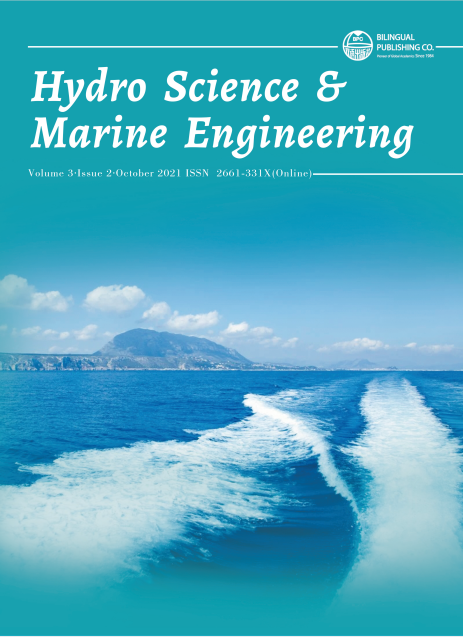Degree of Integrated Water Resources Management Implementation in Context of Climate Change in a Watershed: Case of Oueme Basin, Benin (West Africa)
DOI:
https://doi.org/10.30564/hsme.v3i2.3837Abstract
This study is based on the hypothesis that the implementation of Integrated Water Resources Management (IWRM) tools in the Oueme watershed has not led to a systematic improvement in the degree of IWRM implementation in the Oueme Valley in Benin. Methodologically, data were collected through a semi-structured survey of stakeholder families in the study area using snowball sampling. The tool used was the form developed by the United Nations to collect data to assess the level of IWRM implementation. The four (4) assessment criteria, each covering a key component of IWRM, are the enabling environment, institutions and participation, management tools and financing. The results obtained per criteria according to the stepwise methodology adopted reveal on average a degree of implementation of 40 on a scale of 0 to 100 in the Oueme basin. This value varies according to the geographical area and the factors considered. This study, which is a decision-making tool, provides a guide for governments to monitor the progress of integrated water resources management in their territory.
Keywords:
Application level, IWRM, medium-low, Oueme bassinReferences
[1] R. Q. Grafton and K. Hussey, Water Resources Planning and Management. Cambridge: Cambridge university press, 2011.
[2] C. J. Vörösmarty, P. Green, J. Salisbury, and R. B. Lammers, « Global Water Resources: Vulnerability from Climate Change and Population Growth », Science, vol. 289, no 5477, p. 284-288, juill. 2000. DOI: https://doi.org/10.1126/science.289.5477.284.
[3] OCDE, « OECD Water Studies, Reforming water policies: how to meet the challenge ». 2012. accessed on: https://www.actu-environnement.com/media/pdf/ news-34457-reformer.pdf. [4] B. Zolghadr-Asli, O. Bozorg-Haddad, and C. Xuefeng, « Effects of the uncertainties of climate change on the performance of hydropower systems », Journal of Water and Climate Change, vol. 10, no 3, p. 591-609, 2019. [5] DH (Directorate of Hydraulics ), « Benin Water Vision 2025 », Cotonou, 2000. 17 Hydro Science & Marine Engineering | Volume 03 | Issue 02 | October 2021
[4] F. Cocker, J. B. Vodounou, and J. Yabi, « Mapping of the groundwater potential of the lower Oueme Valley, south Benin (West Africa) », LHB, no 2, p. 74-85, avr. 2020. DOI: https://doi.org/10.1051/lhb/2020018.
[5] F. Cocker, « Mapping and Integrated water resources management in the context of climate change in the lower Oueme valley in Benin (West Africa) », Doctoral School of Agricultural and Water sciences, Parakou, 2020. accessed on: http://rgdoi. net/10.13140/RG.2.2.12999.01447.
[6] General Directorate for Water, « General report on the implementation of the Master Plan for Water Development and Management in the Oueme Basin », DGEau, Benin, Study report 3, 2013.
[7] National Institute of Statistics and Economic Analysis (INSAE), « National Institute of Statistics and Economic Analysis (INSAE) », Directorate of Demographic Studies/INSAE/Primature, Benin, Demographic report, 2016.
[8] C. Codjia, « Perceptions, local knowledge and climate change adaptation strategies of producers in the communes of Adjohoun and Dangbo in South East Benin », Agricultural engineer, University of Abomey-Calavi, Benin, 2009.
[9] F. Legba, « Relevance of the development of the lower Oueme valley in Benin », DESS thesis, option: Hydro-Agricultural Development, 2ie, International Institute of Water and Environmental Engineering, Ouagadougou, Burkina-Faso, 2006.
[10] F. Moniod, « Hydrological regime of the Oueme (Dahomey) », Cah. O.R.S.T.O.M., ser. Hydrol., vol. x, no 2, p. 171-183, 1973.
[11] E. A. Alamou, M. G. L. D. Quenum, E. A. Lawin, F. Badou, and A. Afouda, « Spatial and temporal variability of rainfall in the Oueme basin, Benin », Afrique Science, vol. 12, no 3, p. 315-328, 2016.
[12] F. Cocker, J.-B. K. Vodounou, and J. A. Yabi, « Evaluation of the implementation of IWRM in the lower Oueme valley, south Benin », H2Open Journal, vol. 3, no 1, p. 554-565, janv. 2020. DOI: https://doi.org/10.2166/h2oj.2020.056.
[13] UN Environment, « IWRM Data Portal - SDG IWRM Monitoring », http://www.unepdhi.org/, 2021.
[14] Ministry of Energy and Water, National Water Politics. Cotonou, Benin, 2008.
[15] Ministry of Planning and Development, « National Development Plan 2018-2025 », Cotonou, Benin, 2018.
[16] UN Water, Éd., Water and climate change. Paris: UNESCO, 2020.
Downloads
Issue
Article Type
License
Copyright and Licensing
The authors shall retain the copyright of their work but allow the Publisher to publish, copy, distribute, and convey the work.
Hydro Science & Marine Engineering publishes accepted manuscripts under Creative Commons Attribution-NonCommercial 4.0 International License (CC BY-NC 4.0). Authors who submit their papers for publication by Hydro Science & Marine Engineering agree to have the CC BY-NC 4.0 license applied to their work, and that anyone is allowed to reuse the article or part of it free of charge for non-commercial use. As long as you follow the license terms and original source is properly cited, anyone may copy, redistribute the material in any medium or format, remix, transform, and build upon the material.
License Policy for Reuse of Third-Party Materials
If a manuscript submitted to the journal contains the materials which are held in copyright by a third-party, authors are responsible for obtaining permissions from the copyright holder to reuse or republish any previously published figures, illustrations, charts, tables, photographs, and text excerpts, etc. When submitting a manuscript, official written proof of permission must be provided and clearly stated in the cover letter.
The editorial office of the journal has the right to reject/retract articles that reuse third-party materials without permission.
Journal Policies on Data Sharing
We encourage authors to share articles published in our journal to other data platforms, but only if it is noted that it has been published in this journal.




 Femi Cocker
Femi Cocker

